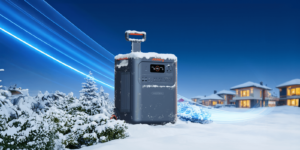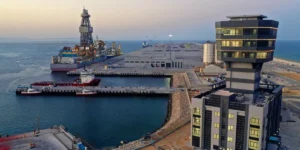Why Do Wind Turbines Have Three Blades Instead of Two or Four?

Wind turbines, those majestic beacons of renewable energy, often feature a trio of blades spinning gracefully against the sky. This design is not arbitrary but is the result of careful engineering considerations aimed at balancing efficiency, cost, and environmental impact.
In this article, I will give an answer to the question ‘Why do wind turbines have three blades instead of two or four?” by unraveling the intricacies behind the design choices that govern wind turbine efficiency, cost-effectiveness, and reliability.
The choice of three blades for most modern wind turbines is a fascinating intersection of aerodynamics, mechanical engineering, and environmental science.
The reason why wind turbines have three blades today
Aerodynamic Efficiency
At the heart of the matter is aerodynamic efficiency. Wind turbines convert the kinetic energy of wind into mechanical power, which can then be converted into electricity. A key factor in this conversion is the design of the blades. Aerodynamically, three-bladed turbines strike an optimal balance between the amount of energy they can extract from the wind and the structural stress placed upon the blades and turbine shaft.
With fewer blades, there’s less drag and material used, which could imply lower costs and higher speeds. However, a single blade or even two blades would lead to significant imbalance and vibration issues. More blades, such as four or more, would increase the turbine’s efficiency in capturing wind energy but also its cost, complexity, and the drag on each blade, reducing the overall system’s efficiency.
Mechanical Simplicity and Cost-Effectiveness
Three-bladed turbines offer a sweet spot in terms of mechanical design and cost-effectiveness. Adding more blades increases the material costs and the weight of the turbine, which in turn requires a stronger, heavier, and more expensive tower and foundation. Furthermore, with each additional blade, there’s a diminishing return in terms of additional energy captured, making the three-blade design a cost-efficient compromise.
Structural Stability
The stability of a wind turbine is paramount for its long-term operation and safety. A three-blade design offers superior stability and balance compared to two-bladed models, which suffer from more dynamic loads and stress. The gyroscopic effect, which stabilizes the turbine as it rotates, is more pronounced in a three-bladed turbine, leading to smoother operation and less wear on the turbine’s components over time.
Noise and Environmental Considerations
Noise production is a significant concern for wind turbines, especially those near residential areas. Three-bladed turbines tend to produce less noise than their two-bladed counterparts because they can operate efficiently at lower rotational speeds. Moreover, the visual impact of wind turbines on the landscape is a non-trivial consideration. Three blades are perceived as less visually intrusive and have a more balanced and aesthetically pleasing appearance than turbines with more blades, which can appear cluttered or excessively mechanical.
The Trade-off Between Speed and Torque
Another consideration is the trade-off between speed and torque. Fewer blades mean that each blade can potentially move faster, ideal for generating electricity. However, more blades can increase torque but at the expense of rotational speed.
The three-blade design offers an optimal compromise, providing enough torque to start turning at low wind speeds while still maintaining a reasonable rotational speed for efficient electricity generation.
Innovation and Evolution
While three blades have become the standard for most modern wind turbines, ongoing research and innovation in the field continue to explore alternative designs and configurations. Engineers are experimenting with variations in blade shape, length, and number to further optimize efficiency and performance.
Four Blades: An Alternative Approach
One alternative gaining traction in recent years is the use of four-bladed turbines. While less common than their three-bladed counterparts, four-bladed turbines offer some distinct advantages.
They can potentially capture more wind energy due to the increased blade surface area, leading to higher energy yields, especially in low wind speed conditions. Additionally, four blades can provide better stability and reduce the cyclic loads experienced by the turbine, potentially extending its lifespan.
Turbine Size and Application
The choice of blade configuration also depends on the size and intended application of the wind turbine. Large-scale offshore wind farms, for example, may benefit from four-bladed turbines due to their enhanced stability and energy capture capabilities. Conversely, smaller onshore turbines may opt for three blades to minimize costs and complexity.
Advancements in Blade Technology
Alongside the consideration of blade number, significant advancements in blade technology have further optimized the performance of wind turbines. Modern turbine blades are crafted using advanced materials such as carbon fiber and fiberglass, offering high strength and durability while remaining lightweight. Additionally, aerodynamic design improvements, such as airfoil shaping and blade curvature, enhance efficiency by reducing drag and improving lift.
Variable Pitch and Rotor Speed Control
Another innovation in wind turbine design is the implementation of variable pitch systems and rotor speed control mechanisms. These features allow turbines to adjust blade angles and rotational speeds in response to changing wind conditions. By optimizing blade pitch and rotor speed, turbines can operate more efficiently across a wider range of wind speeds, maximizing energy capture while minimizing mechanical stress.

Wind power plant in Portugal, image source: Unsplash
Hybrid Systems and Energy Storage Integration
In pursuit of further enhancing the reliability and efficiency of wind energy systems, researchers are exploring the integration of hybrid systems and energy storage solutions. Hybrid systems combine wind power with other renewable energy sources such as solar or hydroelectric power, providing a more stable and consistent energy supply.
Energy storage technologies, such as batteries or pumped hydro storage, enable wind turbines to store excess energy during periods of low demand and release it when needed, improving grid stability and reliability.
Community Engagement and Social Acceptance
Beyond technical considerations, the success of wind energy projects also depends on community engagement and social acceptance. Developers must work closely with local communities to address concerns related to noise, visual impact, and land use. Public outreach, education, and participatory decision-making processes are essential for building trust and fostering acceptance of wind energy developments.

Wind park in Aruba, image source: Unsplash
Environmental Considerations and Wildlife Impact
Beyond efficiency and performance, environmental considerations play a significant role in wind turbine design. Researchers are exploring ways to mitigate the impact of wind turbines on wildlife, particularly birds and bats. Studies have shown that the number and rotation speed of turbine blades can influence the likelihood of bird collisions. By carefully designing turbine blades and considering their rotational speeds, engineers can minimize the risk to wildlife while still maximizing energy production.
Conclusion
The ubiquity of three-bladed wind turbines is a testament to the careful considerations of engineers and scientists aiming to harness wind power most efficiently and sustainably. This design optimizes the balance between aerodynamic efficiency, mechanical simplicity, cost-effectiveness, and environmental considerations.
As wind energy technology continues to evolve, the three-blade turbine stands as a symbol of the current zenith of this balance, offering lessons in how careful design can lead to sustainable solutions in harmony with their environments.






